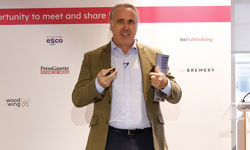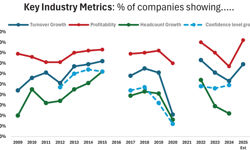For what turned out to be a very positive and forward looking event, it sure got off to a pessimistic start.
According to Dovetail MD Julian Thorne, only 46% of respondents to their annual client satisfaction survey said that they thought 2013 would be a better year for subs than 2012. In 2010, the corresponding figure was 55%. Subs volumes are under pressure, partly driven by media fragmentation, partly driven by publishers hiking up subs prices to maximise revenue.
“Print is declining and that decline will accelerate,” weighed in Douglas McCabe of Enders Analysis. Print & Press accounted for 7.5% of household media spend in 2003. That figure had dropped to 4% now, and would, he predicted, be 3.5% in 2015.
And, the decline had now reached the core women’s magazine market. The middle was being squeezed, said McCabe, and the only silver lining as far as print was concerned was that certain niche sectors were doing well, specifically luxury and specialist.
To exacerbate the situation, the macro-economic outlook is bleak. Due to government cuts, said McCabe, “we think that the economy will flatten and bounce along the bottom for the foreseeable future. Any business dependent on consumer confidence will face challenging times.”
Publishers’ attempts to bring digital centre stage was resulting in huge pressure on IT and web development teams, both within publishers and at their bureaux.
“IT projects are getting incredibly complicated”, said Julian Thorne. Dovetail had seen a huge increase in demand for digital customer service which was putting real pressure on internal systems as “digital products generate four times as many customer service calls as print”, and, so far, the revenue from digital products was not there to support the service.
“We must find new ways of delivering digital customer service for you cost-effectively”, said Thorne, “and, inevitably, this will involve a lot of self service and email support.”
Various speakers during the day dispelled any suggestion that the bulk of the change was behind us and any hope that a more settled future awaited.
The “rate of technological change”, said Google’s Luca Forlin, “will not abate; if anything it will continue to increase. Digital behaviours now are very different to what they were two years ago. What the landscape will look like in twelve months’ time is very hard to determine; there is not much clarity.” We are all, he continued, experiencing ‘Revolution 2.0’.
Luca served up two quotes to illustrate the scale of the challenge:
* Web guru, Mary Meeker: “we’re experiencing the re-imagination of nearly everything, powered by new devices, connectivity, new UI.”
* 2012 PWC media outlook report: “We’re at the end of the digital beginning as companies reshape and retool for life in the new normal.”
The future, Luca said, is simply unknowable.
At which point, you might have thought, the delegates would have thrown their arms in the air and headed for the exit. But, looking around me, what did I see? Shiny happy faces. Err… don’t they get it? We’re all DOOMED!!!!!!!!!!!!!!
Ahem.
Where you might have expected a wailing and gnashing of teeth, there was a real buzz amongst the delegates, and I have seen it at other publishing conferences. Publishers are upbeat! Yes, they are having to work incredibly hard, learn new competencies, balance hugely disparate revenue streams, but the old hang-ups have gone. Yes, print is still an important part of our businesses, but we no longer feel constricted by its legacy. Our digital future does not have to resemble our print present, and this realisation is liberating. And, the future might be unknowable, but there are enough clues around to suggest that it will be highly mobile.
“The shift to mobile”, said Douglas McCabe, “will be the big story for publishers over the next couple of years.” Enders Analysis estimates that there are 35 million smart phones / tablets / e-readers in the UK presently, and that figure will rise to 80 million by 2017 – more than one device per person.
(This increase in mobile penetration should also be seen in the context of the British public’s insatiable appetite for e-commerce. The UK was, said McCabe, “the biggest e-commerce territory in the whole world, per capita, and by a significant way; we are becoming a nation of e-shop keepers.”)
A multiple-device future is the reality, and there are already well-documented differences in usage patterns between smartphones and tablets. Content needs to be shaped by the device, and publishers need to work hard at developing the UX and UI (User eXperience and User Interface) of their mobile offerings.
The key, said Luca, was in first de-structuring your content. Avoid trying to fit a square peg into a round hole. Is the print PDF really the best solution for mobile devices? No.
Incidentally, this pairing down of content is echoed in David Hepworth’s piece in the Jan/Feb issue of InPublishing, where he writes about Marco Arment’s new minimalist magazine proposition, called, err… The Magazine.
But it’s not all about responsive design. Getting the technical and presentational aspects of your mobile offering right is important, but so too is your attitude and outlook. Are you sociable enough? If not, you might be in trouble, says Luca Forlin, because users are “super social”.
There are over 200 million monthly active users on Twitter, over 300 million new photos added to Facebook every day; over 800 million monthly active users on YouTube, watching 4 billion hours of video!
Does the level of publisher activity in the mobile / social space match these trends? I don’t think so. Publishers need to wake up and smell the coffee. If your users are spending so much time on social networks, you should be there too.
The challenge for publishers, said Luca, is to remain relevant to their users, or else they risk being put to one side. “Non social brands will become irrelevant.”
But it’s not just about cosying up to them on Facebook, important though that might be. Relevance is not all about digital. Some publishers are indeed getting closer to their users; just look at the Vogue Café and soon-to-open GQ bar in Dubai, the National Geographic store on Brompton Road, or the Italian publisher organising marathons. It’s all about breaking down barriers.
“If magazines want to remain relevant, they need to get in the middle of where their user is,” said Forlin, who finished his presentation with four survival tips:
1. Follow your users
2. Be aware that different devices impact the UX
3. Enhance and de-structure content
4. Break boundaries
I have focused very much on the mobile themes of the conference, but there were also very interesting presentations from David Reed, editor of DataIQ magazine, on ‘Making real money from your data’ and Jim Bilton, who gave us a sneak preview of the early results from the Dovetail Digital Subscriber Survey. Loads of good stuff there, and we hope to carry a piece looking at the final results of that survey in the May/June issue of InPublishing magazine.
So, the future’s mobile. Agreed? Yes, but the final word belongs to Dovetail MD Julian Thorne: “Don’t forget print!” The future is mobile, but the present is still dominated by print!












